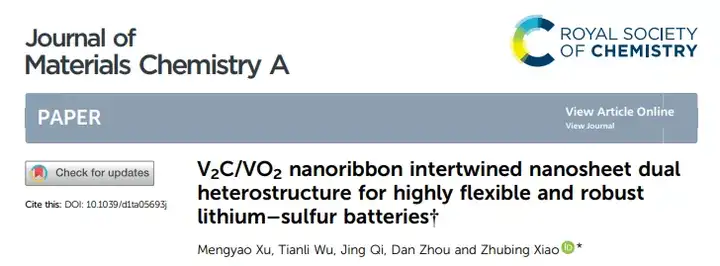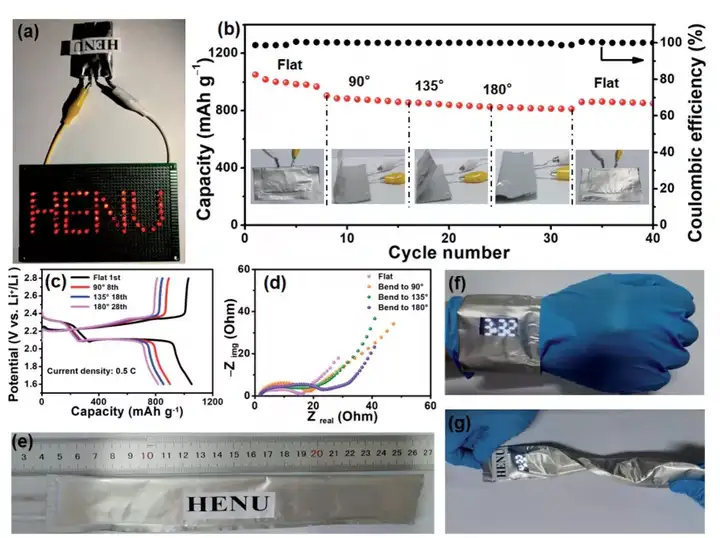Professor Xiao Zhubing, Henan University, JMCA: The latest research progress of flexible high-performance lithium-sulfur batteries based on MXene

Article information
Based on the latest research progress of MXene flexible high-performance lithium-sulfur battery First author: Xu Mengyao Corresponding author: Xiao Zhubing* Unit: Henan University
Based on the latest research progress of MXene flexible high-performance lithium-sulfur battery First author: Xu Mengyao Corresponding author: Xiao Zhubing* Unit: Henan University
Research Background
Lithium-sulfur batteries using sulfur as the cathode material have higher material theoretical specific capacity and battery theoretical specific energy, reaching 1675 mAh/g and 2600 Wh/kg, respectively, but they are mainly due to the insulating properties of sulfur and the shuttle of long-chain lithium polysulfide The effect, leading to its low sulfur utilization rate and poor cycle life, restricts the commercialization of lithium-sulfur batteries. Because of its unique physical and chemical properties, MXenes has attracted much attention in electrochemical energy storage in recent years. However, due to the interaction of van der Waals forces between layers, MXenes nanosheets have a serious tendency to self-stack, which not only causes a large loss of specific surface area, but also increases the difficulty of ion transfer and electrolyte penetration.
Lithium-sulfur batteries using sulfur as the cathode material have higher material theoretical specific capacity and battery theoretical specific energy, reaching 1675 mAh/g and 2600 Wh/kg, respectively, but they are mainly due to the insulating properties of sulfur and the shuttle of long-chain lithium polysulfide The effect, leading to its low sulfur utilization rate and poor cycle life, restricts the commercialization of lithium-sulfur batteries. Because of its unique physical and chemical properties, MXenes has attracted much attention in electrochemical energy storage in recent years. However, due to the interaction of van der Waals forces between layers, MXenes nanosheets have a serious tendency to self-stack, which not only causes a large loss of specific surface area, but also increases the difficulty of ion transfer and electrolyte penetration.
Introduction to Articles
Based on this, Professor Xiao Zhubing’s group from the Provincial Key Laboratory of Photovoltaic Materials of Henan University published a titled “V2C/VO2 Nanoribbon Intertwined Nanosheet Congenetic Dual-Heterostructure for Highly Flexible and Robust” in the “Journal of Materials Chemistry A” (impact factor 12.732) Lithium-Sulfur Batteries" research paper. This paper proposes a double heterostructure with homologous V2C/VO2 nanoribbons grown in situ on V2C/VO2 nanosheets for use in flexible high-performance lithium-sulfur batteries.
Based on this, Professor Xiao Zhubing’s group from the Provincial Key Laboratory of Photovoltaic Materials of Henan University published a titled “V2C/VO2 Nanoribbon Intertwined Nanosheet Congenetic Dual-Heterostructure for Highly Flexible and Robust” in the “Journal of Materials Chemistry A” (impact factor 12.732) Lithium-Sulfur Batteries" research paper. This paper proposes a double heterostructure with homologous V2C/VO2 nanoribbons grown in situ on V2C/VO2 nanosheets for use in flexible high-performance lithium-sulfur batteries.

Figure 1. (a) The soft-packed battery can light up the HENU-shaped LED light in the folded state; (b) The cycle performance of the soft-packed battery in different folded states at 0.2C; the soft-packed battery in different folded states (c) Charge-discharge curve and (d) impedance spectrum; (e) optical photo of the soft pack battery; (f) and (g) optical photo of the flexible soft pack battery powering the electronic watch.
The main points of the article
Key point 1: The advantages of the synthesized Mxene-based double heterostructure material combined with the results of spectroscopy and theoretical calculations prove that this double heterostructure has good electrolyte permeability, unimpeded three-dimensional Li+/e transmission and abundant electroactive centers , Is an ideal sulfur-carrying material in high-load lithium-sulfur batteries. The synthesized VCOR-VCOS double heterogeneous flexible electrode can achieve an area capacity of up to 9.3 mAh cm-2 under a high sulfur load of 8.6 mg cm-2, and still retains an area of 5.4 mAh cm-2 after 70 cycles. capacity.
Key point 1: The advantages of the synthesized Mxene-based double heterostructure material combined with the results of spectroscopy and theoretical calculations prove that this double heterostructure has good electrolyte permeability, unimpeded three-dimensional Li+/e transmission and abundant electroactive centers , Is an ideal sulfur-carrying material in high-load lithium-sulfur batteries. The synthesized VCOR-VCOS double heterogeneous flexible electrode can achieve an area capacity of up to 9.3 mAh cm-2 under a high sulfur load of 8.6 mg cm-2, and still retains an area of 5.4 mAh cm-2 after 70 cycles. capacity.
Key point 2: Application potential of flexible energy storage devices Flexible self-supporting electrodes do not use binders and organic solvents, the preparation process is easy to operate, and its good mechanical flexibility can prevent energy storage devices from being damaged under external forces. Mxene material has a rich pore structure and high conductivity, and is an ideal flexible self-supporting electrode substrate material. With a sulfur load of up to 6.0 mg cm-2 and a low electrolyte consumption (4.5 μL mg-1), the soft-pack lithium-sulfur battery can reach an initial surface capacity of 6.3 mAh cm-2, and after any folding It still has a reversible surface capacity of 5.2 mAh cm-2, which makes lithium-sulfur batteries take another solid step toward application.
Article link
V2C/VO2 Nanoribbon Intertwined Nanosheet Congenetic Dual-Heterostructure for Highly Flexible and Robust Lithium-Sulfur Batterieshttps://doi.org/10.1039/D1TA05693J
Brief Introduction of Communication Author
Xiao Zhubing, Ph.D., professor, fourth-level distinguished professor of Henan University "Special Zone Support Program", and leader of the high-density energy storage device project group of the Provincial Key Laboratory of Photovoltaic Materials.Has long been engaged in the research on the positive and negative electrode modification of lithium/potassium-sulfur batteries. So far, as the first author and corresponding author in Adv. Mater (1), Adv. Energy Mater (2), Adv. Funct. Mater (1), ACS Nano (4), Nano Energy (1), Energy 17 papers have been published in academic journals such as Storage Mater (2) and Journal of Chemistry A (3), among which 14 papers with impact factor greater than 10, 3 highly cited papers, and more than 1,200 citations.
Xiao Zhubing, Ph.D., professor, fourth-level distinguished professor of Henan University "Special Zone Support Program", and leader of the high-density energy storage device project group of the Provincial Key Laboratory of Photovoltaic Materials.Has long been engaged in the research on the positive and negative electrode modification of lithium/potassium-sulfur batteries. So far, as the first author and corresponding author in Adv. Mater (1), Adv. Energy Mater (2), Adv. Funct. Mater (1), ACS Nano (4), Nano Energy (1), Energy 17 papers have been published in academic journals such as Storage Mater (2) and Journal of Chemistry A (3), among which 14 papers with impact factor greater than 10, 3 highly cited papers, and more than 1,200 citations.
Introduction to the first author
Xu Mengyao is a graduate student in Henan University. The tutor is Professor Xiao Zhubing. His research direction is potassium ion battery and alkali metal sulfur battery. Since enrollment, he has published 2 research papers in Small, J. Mater. Chem. A international journals as the first author.
Xu Mengyao is a graduate student in Henan University. The tutor is Professor Xiao Zhubing. His research direction is potassium ion battery and alkali metal sulfur battery. Since enrollment, he has published 2 research papers in Small, J. Mater. Chem. A international journals as the first author.
This information is sourced from the Internet for academic exchanges only. If there is any infringement, please contact us to delete it immediately.
+86-18915413828(WhatsApp&WeChat)
Previous: Ji Jian/Jin Qiao/Zhou


